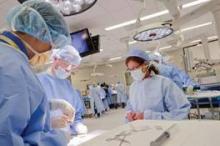At the Vascular Annual Meeting, he reiterated his support for simulator training, and discussed the success of the aviation model of simulation in detail.
The Case for Simulation
If adopting simulation is all but inevitable, how best to do it? The dainty morsels vs. pig-in-a-python approach was at the crux of a debate held at the Vascular Annual Meeting session. On the pro-simulation side, Dr. Alan B. Lumsden of the Methodist DeBakey Heart and Vascular Center, Houston, saw simulation as "the wave of the future."
Dr. Lumsden was adamant in saying that the costly, high-fidelity virtual reality systems are not what simulation training for residents should be about. He used CPR dummies as an example of one of the most effective simulators. These cost "about a hundred bucks a pop," compared with some $250,000 systems, he noted, adding that almost every senior vascular surgeon beside him on the podium learned how to do endovascular procedures on foam rubber iliac and aortic stenosis models (including his debate adversary, Dr. Michael S. Makaroun).
"The question is not whether simulation is valid, but the question is whether we as vascular surgeons can figure out how to take what we have learned and learn how to apply that [to simulations]." His major point was that there should be a focus on simulation and how to standardize its use. He indicated that in single tasks, simulation could be made ideal, such that eventually "we should be all doing the procedure in the exact same way," and he gave the example of groin puncture to access a femoral vessel as one good place to start.
Dr. Lumsden also pointed out the critical validity of simulation for team training. He used the example of extracorporeal membrane oxygenation (ECMO) training simulation, and said that much could be learned from the Fundamentals of Laparoscopic Surgery program, a simulation program required in order to get certification and graduate in a general surgery residency. The system includes a kit that allows surgeons to practice at home and online to learn skills, he said.
"We need to build ‘Fundamentals of Endovascular Surgery,’ " he asserted. "We can do this and do it relatively easily and relatively cheaply. ... It’s not debatable as to whether this is of value. It’s debatable whether we can figure out how to do it and institute it into vascular surgery on a daily basis."
A Global Concern
Just what level of simulation is appropriate is an international question, and a recent analysis of how best to expand the use of simulation in open vascular surgical training was presented by Dr. Vikas A. Pandey and Dr. John H.N. Wolfe of the Imperial College Healthcare NHS Trust, London. In a recent article, they discussed one major issue in simulation that has created considerable concern in the vascular community especially – the comparative ease of simulating endovascular and laparoscopic approaches (which can be simulated using a two-dimensional imaging approach, and is one of the driving forces behind the simulation movement) as compared with open surgery, which requires a three-dimensional field to be representative of the procedure and is much more difficult to simulate effectively (J. Vasc. Surg. 2012 [doi: 10.1016/j.jvs.2012.04.015]).
Dr. Pandey and Dr. Wolfe indicated that a wide range of simulators exist for all aspects of vascular surgical training, and that these vary in complexity and price, from simulators suitable for use at home or in a local skills laboratory to those that can only be practically implemented at a regional skills center.
But even the latter are not the highest levels of simulation required. The authors suggested that higher levels of simulation training require more stringent considerations. "Where surgical procedures are not commonly performed or expertise is required for a new innovation, it is more appropriate to have national or internationally based workshops under the auspices of surgical boards or societies," they wrote.
Finding consensus on the best method for implementing simulation-based training in a surgical curriculum also remains a thorny subject. Dr. Zevin and his colleagues from the United States reported on their attempt to achieve international consensus. They used an iterative, online Delphi survey to develop a consensus among 24 international experts with training ranging from general surgery to vascular surgery. The final framework agreed upon for resident training was the need for predevelopment analysis of trainees; cognitive, psychomotor, and team-based simulation training; and methods of curriculum validation, evaluation, and improvement. A consensus was also reached by greater than 80% on the need for simulation for maintenance of training.

